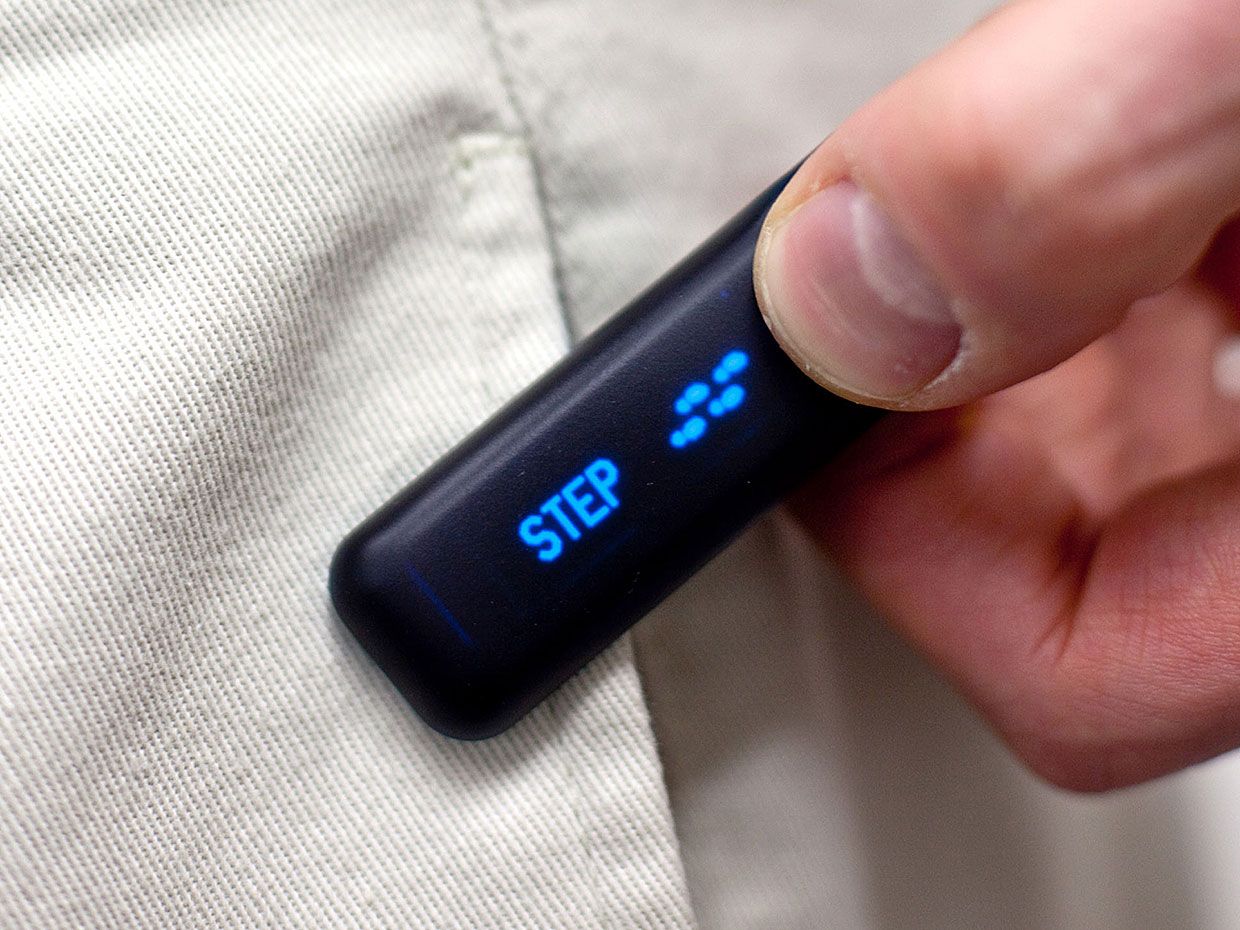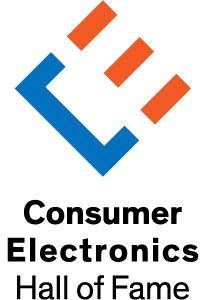The Consumer Electronics Hall of Fame: Fitbit
 Photo: Peter DaSilva/The New York Times/Redux The First Fitbit: Introduced in 2009, the pioneering fitness tracker had a blue OLED display and was designed to be clipped to clothing rather than worn on the wrist.
Photo: Peter DaSilva/The New York Times/Redux The First Fitbit: Introduced in 2009, the pioneering fitness tracker had a blue OLED display and was designed to be clipped to clothing rather than worn on the wrist.  Enter Here < Back to Consumer Electronics Hall of Fame
Enter Here < Back to Consumer Electronics Hall of Fame As early as the 1940s, people became enchanted with the idea of electronic devices so small you could wear them like a wristwatch. During the heyday of vacuum electronics, the Dick Tracy comic strip in the United States envisioned wrist-worn radios and televisions, examples of what we'd call "wearables" today. Then, in the 1970s, electronic wristwatches took the market by storm, around the same time that handheld calculators were also becoming popular. Combining the two seemed like a good idea, at least to some people. So manufacturers tried it, with some limited commercial success starting in the late 1970s.
As time and technology progressed, the engineering work naturally moved on from calculators to computers you could wear on your wrist. But for decades the computer watch remained stubbornly unpopular. Among the companies that tried and failed early on were Casio, Epson, Sony, IBM, and Microsoft.
The first computer-powered wearable to achieve huge, breakout success proved most futurists almost completely wrong regarding form, features, and function. The Fitbit, when it was introduced in 2009, had a rudimentary LED screen capable of displaying only numbers. Nor was it worn on the wrist; it clipped to a pocket or waistband. And it tracked fitness metrics-steps taken, distance traveled, and (estimated) calories burned.
It was a modest start for a company that would come to dominate the nascent field and, in November 2019, be bought by Alphabet's Google in a blockbuster deal. The US $2.1 billion acquisition was seen by analysts as an attempt by Google to shore up its position in the burgeoning wearables market, where rival Apple has enjoyed substantial success with its watch and associated fitness-tracking apps for the iPhone.
Early on, there was hardly a hint that such a lofty perch would be attained. The Fitbit grew out of a quest to make a wearable that was something other than a computer watch, and also out of the zeitgeist. Fitness has of course been in the public consciousness for a very long time, going through erratic cycles, like the hemlines on skirts. In the 1960s a walking craze took place in Japan; it might be the earliest instance of the 10,000-step ethos. In the 1970s, jogging (now known as "running") became popular in America and then spread out to other nations; around the same time mall walking would become a thing among older Americans. The activities caused sales of pedometers to surge. Other fitness-related metric activities also benefited, too. Dieters had long tracked estimates of calories ingested and burned through programs such as Weight Watchers (founded in 1963). And the President's Council on Sports, Fitness and Nutrition, which dates back to 1956, always encouraged people to keep logs of their fitness activities.
Counting steps, tracking calories, and logging miles run, cycled, or swum dovetailed precisely with another long-term societal trend: measuring and quantifying everything that can be measured and quantified. That's the line running through such disparate modern activities as setting recommended daily allowances for vitamins and minerals, predicting the number of transistors on a die, and closely tracking the performance of professional athletes.
Measuring everything has led to analysis. For many businesses, collecting and analyzing data long ago became an imperative. For some individuals, meanwhile, doing so has become an obsession.
By the early 2000s, the basic technological elements for a fitness tracker were readily available. Accelerometers, which are used to track motion, had become accurate, easy to fabricate, and cheap. There were multiple options for transferring data from the tracker, including physical ones, like USB ports and cables, as well as wireless options like Bluetooth and Wi-Fi.
 Photo: Peter DaSilva/The New York Times/Redux Ivy League Cofounders: James Park [left] conformed to Silicon Valley tradition by dropping out of Harvard before starting his first company. Cofounder Eric Friedman broke with tradition by graduating from Yale.
Photo: Peter DaSilva/The New York Times/Redux Ivy League Cofounders: James Park [left] conformed to Silicon Valley tradition by dropping out of Harvard before starting his first company. Cofounder Eric Friedman broke with tradition by graduating from Yale. Fitbit was founded in 2007 as Healthy Metrics Research by James Park, now the CEO, and Eric Friedman, chief technology officer. Park and Friedman have been open about how difficult the development of the Fitbit was. They've acknowledged starting out with so little experience in manufacturing that one of their early demos consisted of a circuit board inside a balsa wood box. Going in to a subsequent demo, a problem with the antenna rendered the device inoperable until Park fixed it by attaching a piece of foam to the circuit board. Park is on record citing seven distinct occasions when a combination of unanticipated manufacturing difficulties and capital shortfalls nearly killed the startup.
Fitbit's exceedingly fitful progress allowed competitors to get to market first. Apple, collaborating with Nike, got there in 2006. Their Nike+ included a chip that fit into a receptacle that Nike built into a special line of sneakers. The chip tracked pace, distance traveled, and other metrics, and connected wirelessly with a receiver module that users plugged into an iPod. Other competitors at the time included Philips, with its DirectLife Activity Monitor, which showed your daily progress toward your preset goals as a series of glowing LED dots. Another one was BodyMedia, a Massachusetts startup that produced a series of armbands, at least one of which was marketed as the Bodybugg by a company called Apex Fitness.
Fitbit, meanwhile, persevered and got its first device to market toward the end of 2009. That first Fitbit looked like a futuristic black clothespin. The Fitbit linked wirelessly with a PC to transfer data. It measured steps and distance traveled, estimated calories burned, and reported hours active versus hours sedentary. In marketing materials, the company also said customers could wear it at night so they could gauge the extent to which they tossed and turned-presumably an indication of the quality of their sleep. It was priced at $99; the company sold about 5,000 units by the end of the year and reportedly had an additional 20,000 orders logged.
The original Fitbit was an ugly little thing, but its biggest advantage may have been what it lacked: a fatal flaw. All of Fitbit's rivals had at least one characteristic that proved to be a drawback. The Philips and Bodybugg products were too bulky, where the Fitbit was sleek and light. The Nike+ kit was complicated, and it also required an iTunes subscription, where Fitbit was simple to use and provided free access to its Web portal and analytical software.
That website was key. The developers made an effort to make it easy not just to log fitness data but also to keep track of food intake. For example, they gathered nutritional data from many of the biggest chain restaurants in the United States. Fitbit users could simply identify what they'd eaten and the system would automatically fill in values for calorie intake. The process was familiar to anyone who had experience with Weight Watchers, except it was automated.
Partly because of these advantages, Fitbit was already emerging as a market favorite when it got a big boost from the U.S. electronics chain Best Buy, which began stocking its products in some of its stores in 2010. More big retailers around the world followed. The company built momentum. Subsequent competitors, including Garmin, Jawbone, Misfit, and Xiaomi, got into the market too late to catch up.
 Photo: Josep Lago/AFP/Getty Images Arm Bandy: After several years of selling fitness trackers that clipped to clothing, Fitbit introduced the Flex, its first wrist-worn tracker, in 2013.
Photo: Josep Lago/AFP/Getty Images Arm Bandy: After several years of selling fitness trackers that clipped to clothing, Fitbit introduced the Flex, its first wrist-worn tracker, in 2013. One of Fitbit's next models was indeed worn on the wrist. The company also kept gradually adding features. In 2011 it produced a model called the Ultra that also incorporated an altimeter, a digital clock, and a stopwatch.
The computer watch might have taken off on its own, but in retrospect it seems pretty obvious that fitness trackers helped pave the way. It wasn't until a few years after fitness trackers became common that computer watches-we now call them smart watches-finally began succeeding in the marketplace, in 2012. Early on, makers of smart watches tried to integrate fitness functions, but for whatever reason, consumers wouldn't be charmed by a combo device for at least a few more years.
In 2014, Fitbit had 77 percent of the market for "full-body activity trackers," according to the market research company NPD Group, as well as the No. 1 fitness app in Apple's App Store.
Around 2015, fitness trackers began being subsumed into smart watches. For reasons nobody has ever quite fathomed, people finally became receptive to the concept. Smart watches with fitness-tracking capability naturally began eating into the market for stand-alone trackers. Around the same time, it became apparent that there were simply too many companies making wearables, and some of them began to consolidate. Jawbone bought BodyMedia, maker of the Bodybugg wearable, in 2013. Fossil bought Misfit in 2015. Fitbit bought Pebble in 2016 and Vector Watch in 2017. That same year, Fitbit introduced its first Fitbit-branded smart watch.
Even though fitness tracking is being subsumed into smart watches, the market for stand-alone fitness trackers was nonetheless projected to keep growing in 2019, to $3.3 billion in global sales, according to the market research firm Statista. Fitbit was still the clear leader in the market as recently as 2016 (the last year for which Statista publicly released numbers); back then it had a 47 percent share, followed by Xiaomi, with 27 percent. No one else had anywhere near double digits.
Looking at the global market for all types of wearables (smart watches, fitness trackers, and other devices), as of 2018 Fitbit ranked behind only Xiaomi and Apple, the dominant smart-watch vendors. Late in 2019, with the power of Google behind it, Fitbit seemed poised for a run at the top.
Back to Consumer Electronics Hall of Fame >> < Back to Consumer Electronics Hall of Fame